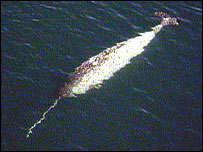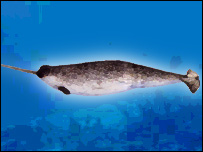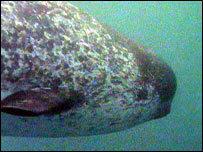|
Dr Heide-Joergensen, of the Greenland Institute of Natural Resources, conducted his investigation of Narwhal numbers in the Inglefield Bredning area of the island and its adjacent fjords.
He carried out two separate surveys in August 2001 and August 2002, using two digital cameras that continuously download images to separate laptop computers.
Image survey
The 2001 survey, repeated four times, covered an area of 840 sq km and counted 360 narwhals. The 2002 survey, repeated seven times covered an area of 2,208 sq km and counted 566 narwhals.
When compared with the results of surveys conducted in 1985 and 1986, the estimates currently show a 10% decline per year.
NARWHAL - MONODON MONOCEROS
Spiral horn normally found on the male and can grow to 3m
Its purpose is not entirely clear but males are known to joust
Narwhals will eat fish, squid, krill and other crustaceans
However, Dr Heide-Joergensen said the decline could be much bigger because the 80s studies did not correct for perception bias, which is designed to take account of the fact that some whales may be present at the surface and not seen by the observers.
Narwhals (Monodon monoceros) are hunted intensively by the indigenous people of Greenland, the Inuit.
In 1999, a long-standing policy of regulating the hunt in Nunavut, eastern Canada, was abandoned. In Greenland, no direct measures for regulating the hunt have ever been taken.
"They take [the narwhals] for the tusk but they also hunt them for the skin and the meat. The skin is rich in vitamin C, which is a good defence against scurvy when you don't have vegetables," Dr Heide-Joergensen told BBC News Online.
Fishing grounds
However, several other factors also threaten the animals.
The developing halibut fisheries in Greenland may
impact the narwhals because the animals rely on
the fish when they winter in central Baffin Bay.
|


